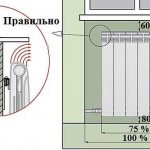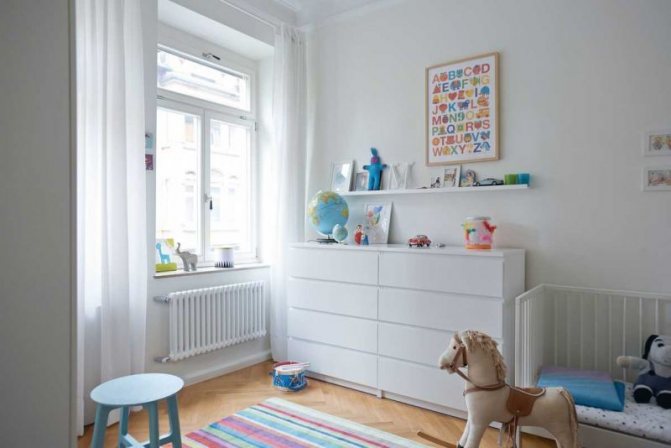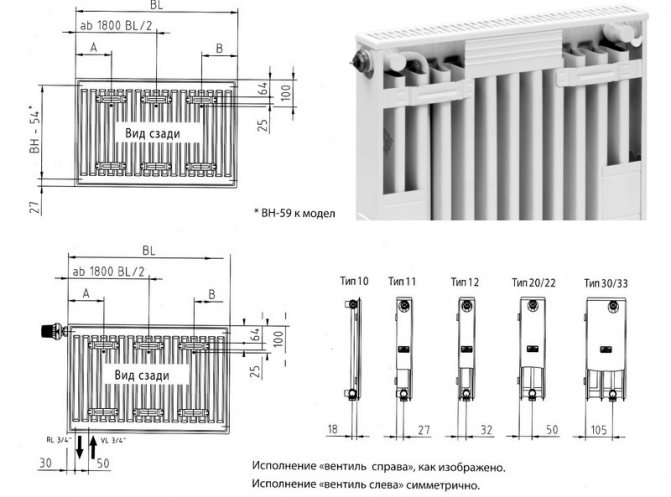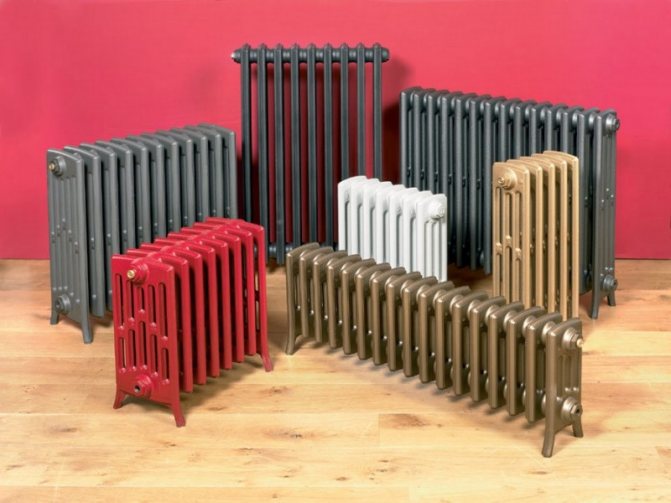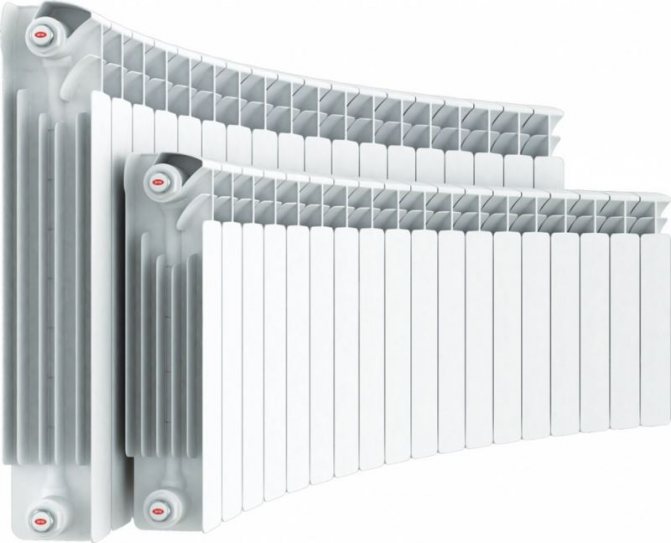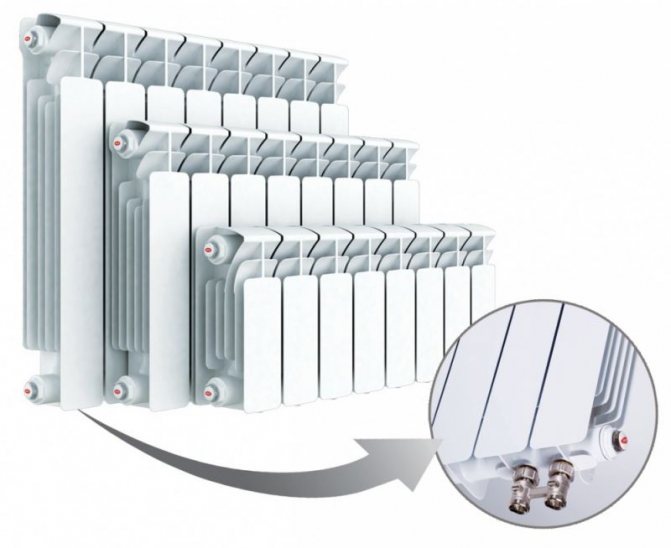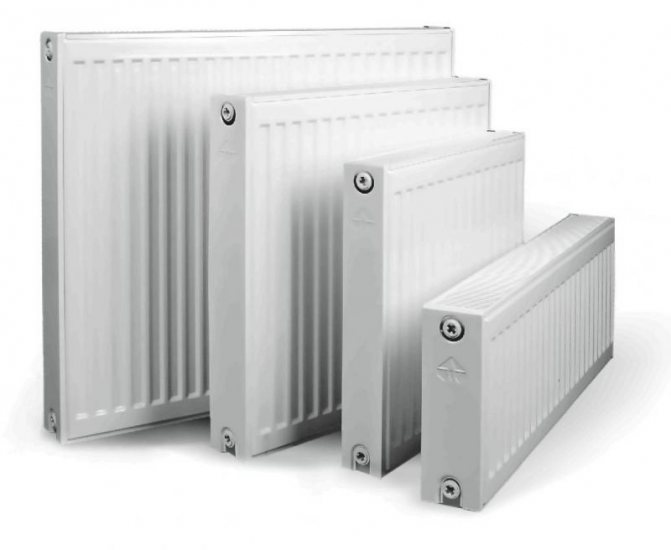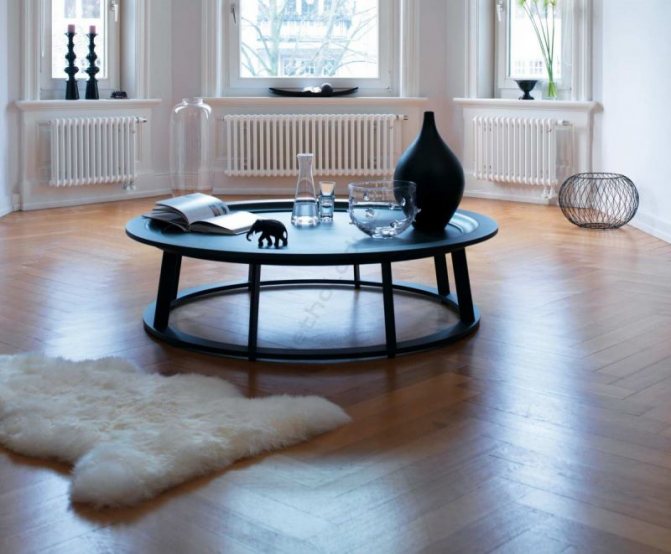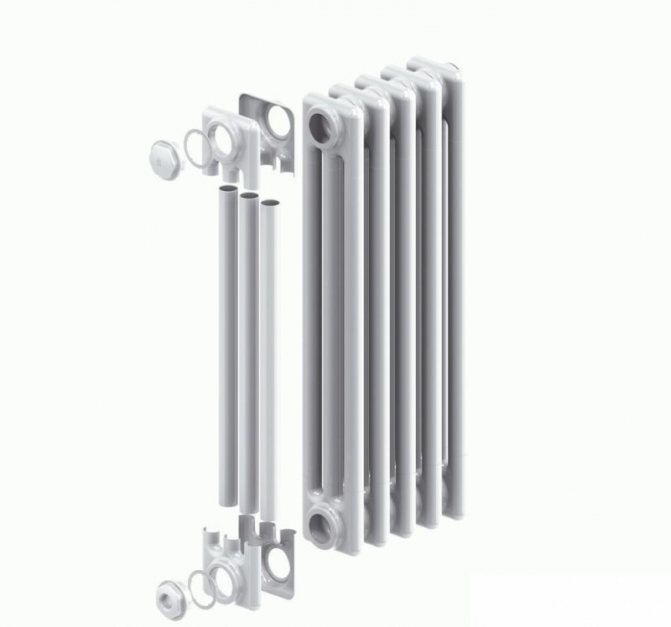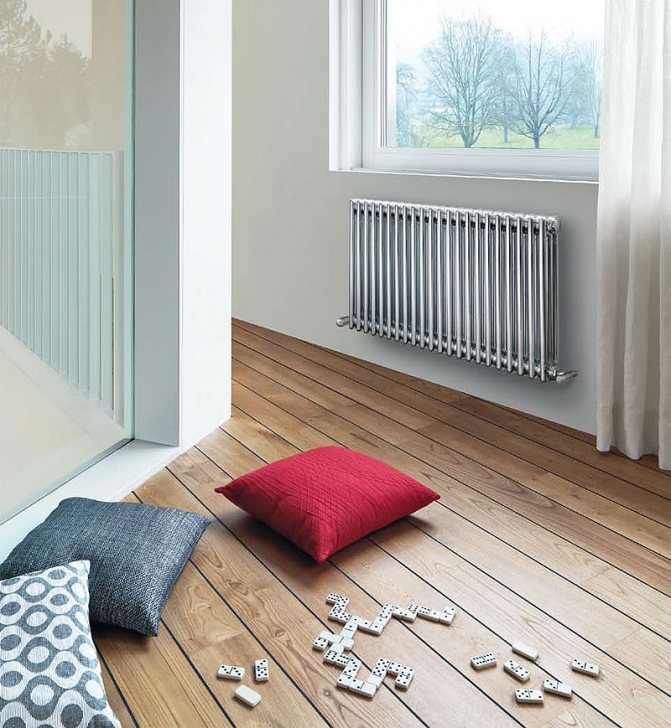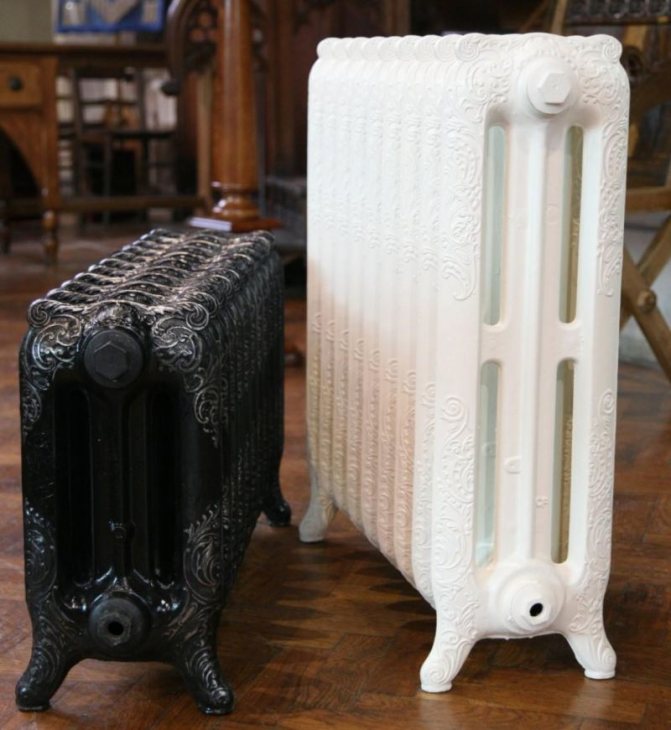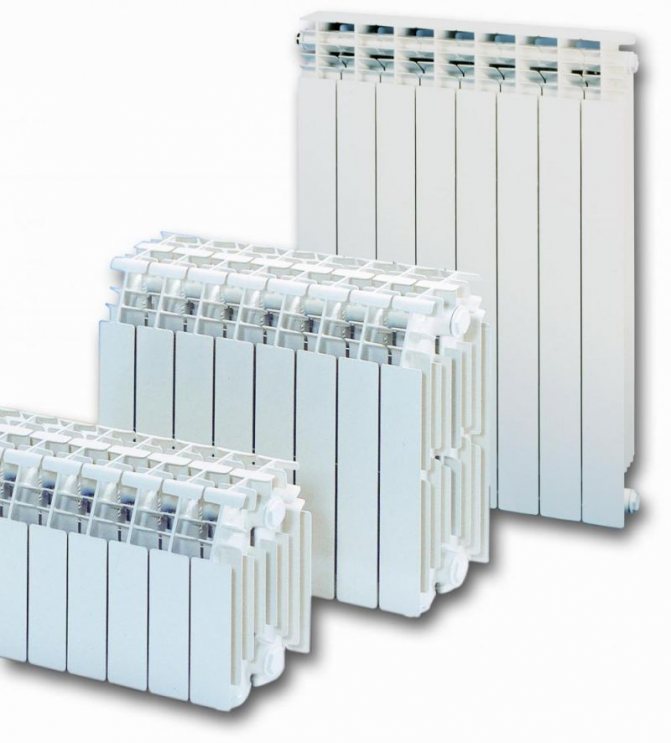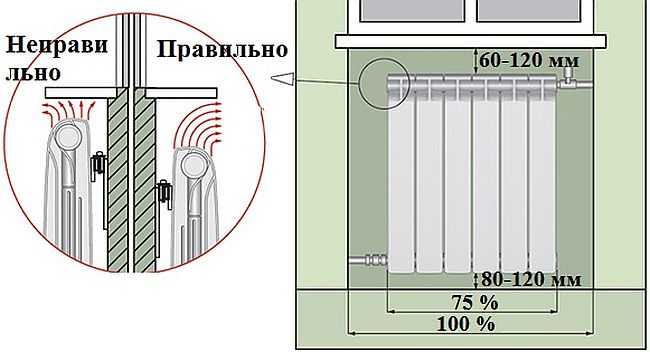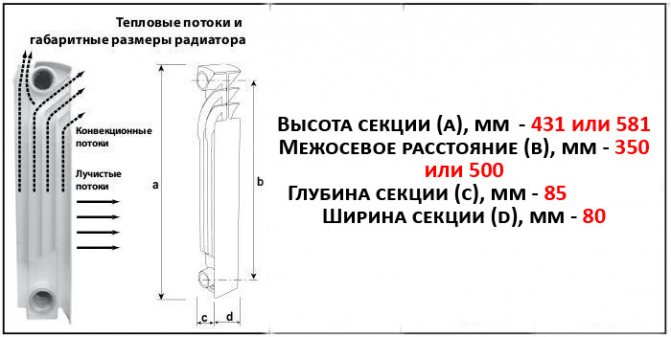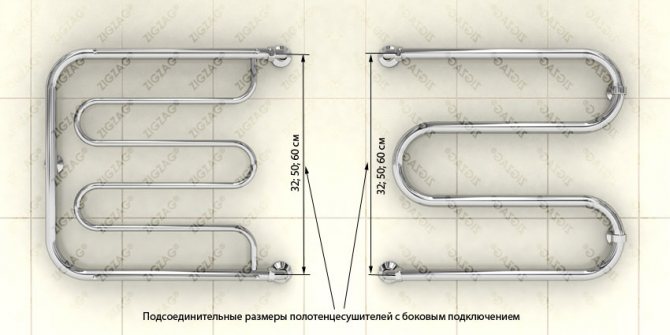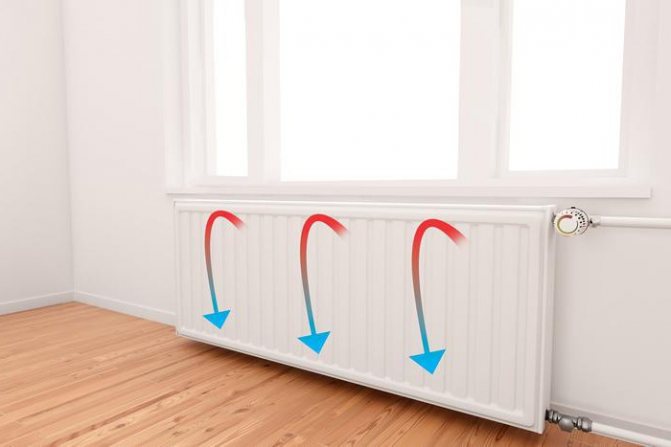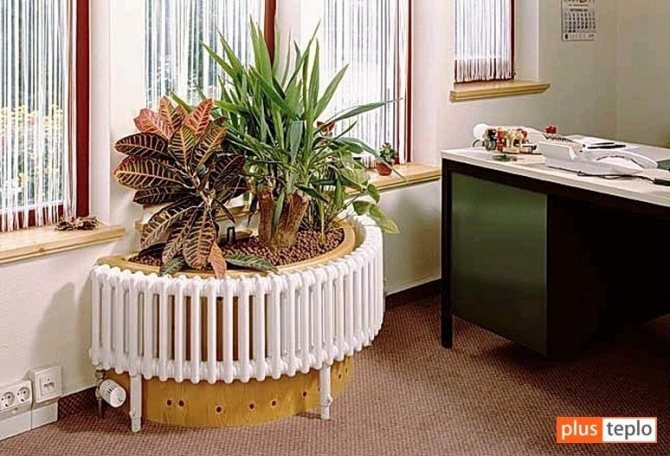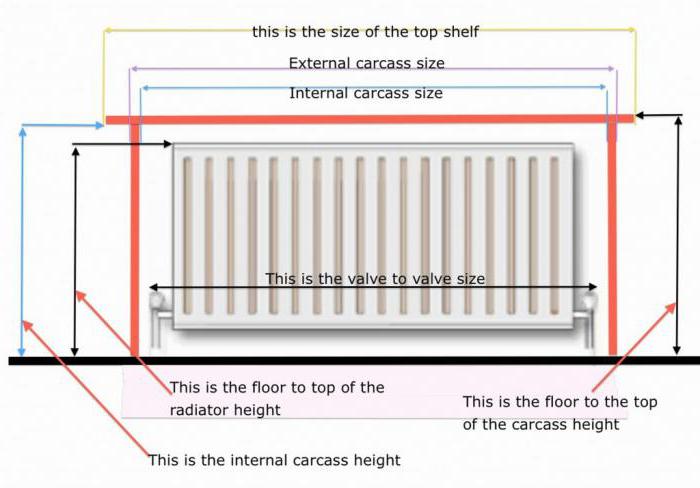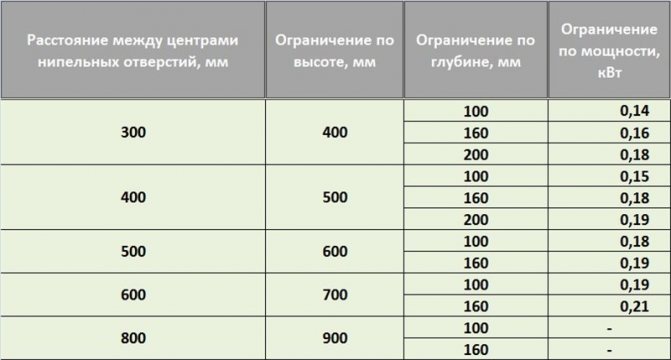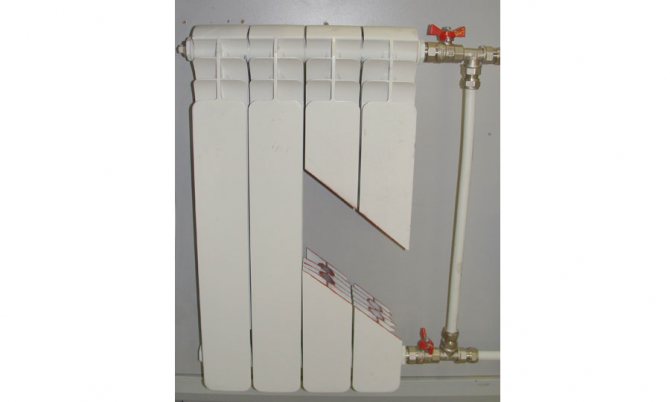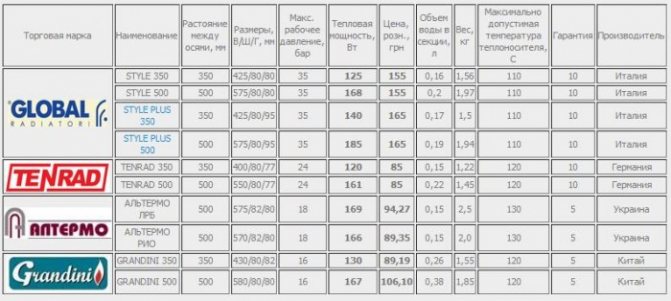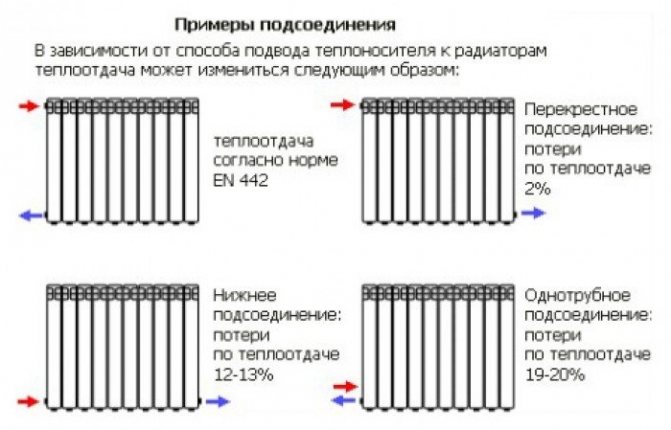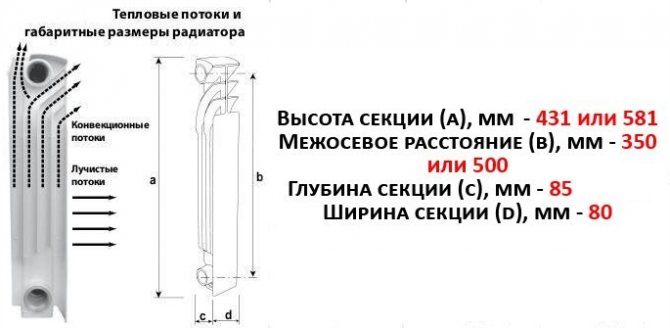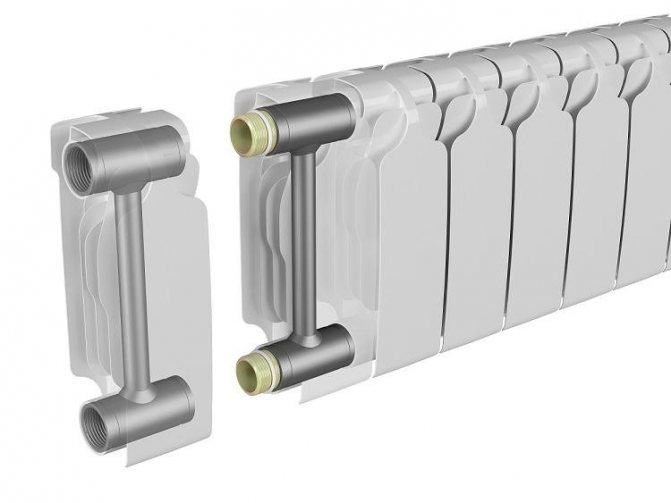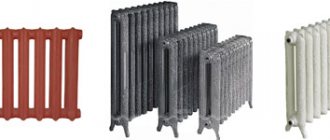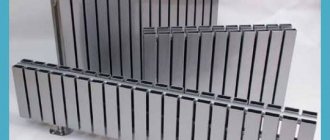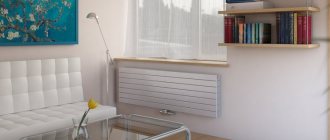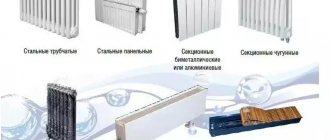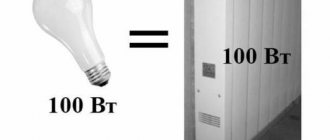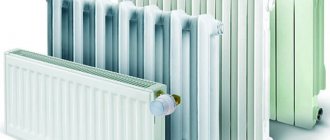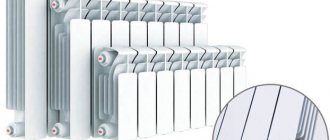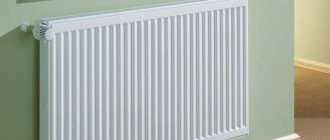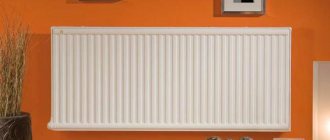What should be the dimensions of the radiators
The choice of the dimensions of heating devices is not based on aesthetic considerations. Heat transfer plays the main role here. This is especially true if a model is selected for installation under a window. You need to choose a model in such a way as to meet several requirements at once:
- the length of the radiator must cover at least 70-75% of the width of the window opening;
- the distance from the floor should be 80-120 mm;
- from the window sill 60-120 mm.

When choosing the dimensions of the radiator, you need to select them depending on how high the window sill is
Only under such conditions will the heat transfer of the heating device you choose be normal: it will give out the number of watts declared by the manufacturer.
Terminology
Often in descriptions and specifications there is the concept of "center distance". Sometimes the term "inter-nipple" and "inter-center" or connecting dimensions is found. These are different names for the same size. It is defined as the distance between the centers of the inlet openings of a section or a radiator.
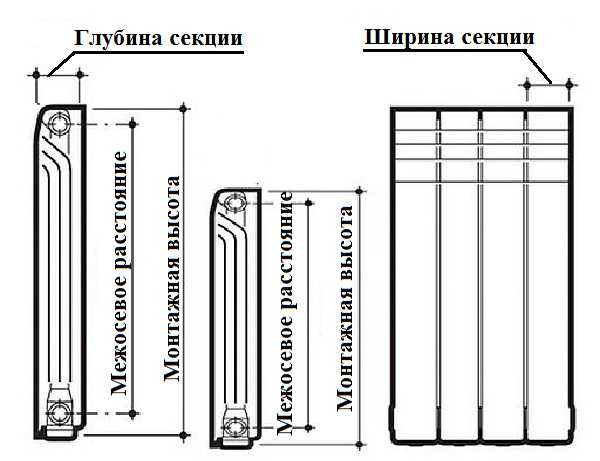

In the technical characteristics of radiators, there is often such a thing as the center distance
This parameter is important if the supply pipes are in good condition and there is no need to change them. In this case, in order not to digest the liner, you can choose a model with the same center-to-center distance as the old radiators.
The overall dimensions of the section itself or the radiator are described by the following parameters:
- mounting height;
- depth;
- width.
If the radiator has a sectional structure, then the depth and width refer to the dimensions of the section. Moreover, the depth of the radiator will be the same, and the width of the battery depends on the required number of sections (you need to add about 1 cm more to the gaskets that fit for tightness of the joints).
The names of radiators often contain numbers: RAP-350, Magica 400, Rococo 790 or RAP-500. The numbers are the center distance indicated in millimeters. This makes it easier for both the buyer and the seller to navigate. The fact is that with the same center distance, the mounting height can differ significantly. Therefore, the specification is set to the most accurate value.
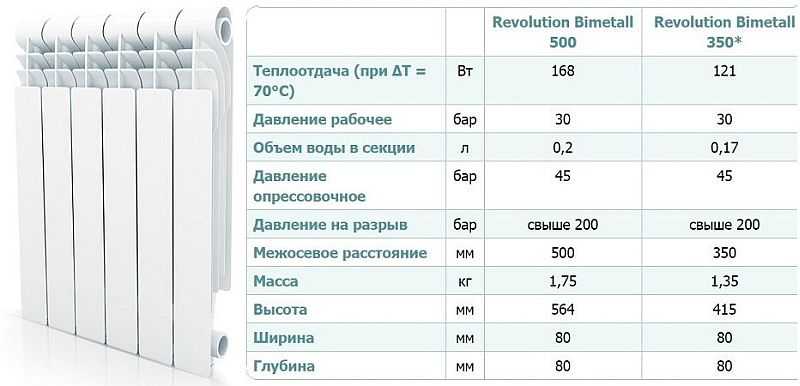

An example of technical characteristics. This is the Revolution Bimetall model
The radiator parameters that may need to be taken into account include the volume of water in the section. For apartments connected to centralized heating, this characteristic does not affect anything, but for individual systems it is important: when it is necessary to calculate the volume of the system (to determine the boiler performance or pump characteristics).
And the most important, perhaps, parameter is thermal power. It should be noted that the highest power is not always necessary. Increasingly, in apartments and houses with good thermal insulation, heating devices of medium power are required, and not huge.
When selecting the thermal power of one section, it must be remembered that the radiator under the window must cover at least 75% of the width of the window opening. Then the room will be warm, there will be no cold zones and the glass will not "sweat". Therefore, it is better to take 10 less powerful sections than 6 pieces with high heat output.
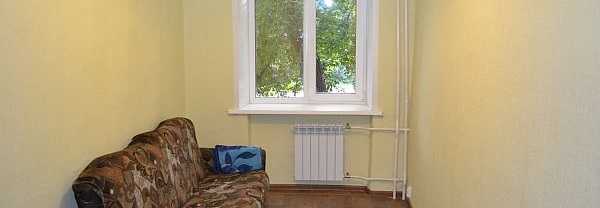

Such a radiator may deliver the required power, but there will be clearly cold and warm zones in the room.
The standard window width is 1100-1200 mm. Accordingly, 75% is 825-900 mm. This is the length or more your battery should be.Running a little ahead, let's say that the average width of one section of an aluminum radiator is 80 mm, which means that you will need 10-12 sections.
Radiator types
In Soviet times, all batteries were the same in appearance, representing bellows from an accordion. Modern radiators, including bimetallic ones, are produced in different types. Monolithic specimens form a section assembled entirely from steel tubes that cannot be disassembled. The dimensions of such a heater device cannot be changed: reduce or increase the number of nozzles. If the thermal power of the battery for a particular room is calculated correctly, then a more reliable heating device cannot be found. Such batteries will withstand pressure up to one hundred atmospheres. They are the most expensive bimetallic heaters on the market.
Collapsible (sectional) models make it possible to determine the parameters of the radiator section required for a particular room. To provide real warmth in an apartment, before buying a device, you must first determine what its power should be, taking into account any heat loss. The capacity of the heater directly depends on its size. The smaller the capacity, the more economically the heating device functions.
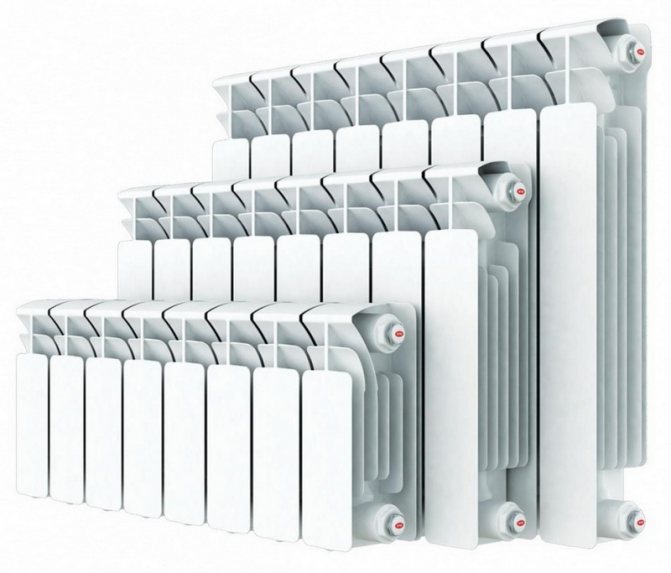

Standard height
When talking about the standard height, they mean a center distance of 500 mm. These are the connecting dimensions that the well-known cast-iron "accordion" of Soviet times had. And since they have a long service life, these batteries are still in heating networks. Only now they are being replaced with new ones. Moreover, they often do not want to redo the system, so they are looking for heating devices of the same size. What's good: they are in almost every group.
Cast iron
Today, not only the "accordion" is made of cast iron, although it exists and is popular. There are also retro-style radiators with a center distance of 500 mm, made in a modern style:
- "Accordion" is called MS-140, MS-110, MS-90 and MS-85. These modifications differ in depth: 140, 110, 90 and 85 mm, respectively. The width is also different. Moreover, it differs from different manufacturers of the same model. So the MS-140 of the Minsk plant has a width of 108 mm, and of the Bryansk and Novosibirsk ones - 93 mm.
- Cast iron radiators in a retro style with a center distance of 500 mm, the appearance and dimensions will be completely different. Let's say, the Modern 500 model. Sections with legs, dimensions 645 * 100 * 45 mm, without legs 572 * 100 * 45 mm, heat power 93 W. And the other DERBY M 500 has dimensions of 660 * 174 * 63 mm and a heat dissipation of 118 W (where the dimensions are designated as height * depth * width).
- Cast iron batteries of the new model also have a decent range of parameters. Turkish Demrad Ridem 3/500 - 572 * 98.2 * 60 mm, Demrad Ridem 4/500 - 572 * 134 * 60 mm. Czech Viadrus Style have the following dimensions: height 580 mm, width - 60 mm, depth is not indicated due to its non-linear shape (narrower at the top, wider at the bottom).

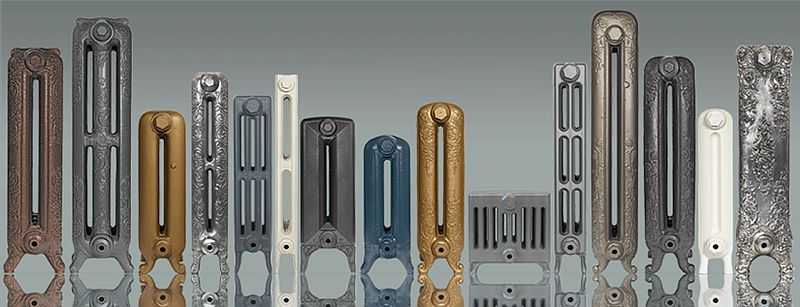
Cast iron batteries can have such dimensions today.
Aluminum
The dimensions of aluminum radiators are more standardized. Here you can even talk about average values. With a center-to-center distance of 500 mm, the average section height is 570-585 mm. Almost standard width is 80 mm. There are options in depth. There are practically flat ones: Russian-made "Thermal" radiators have a depth of only 52 mm. These are the flattest aluminum batteries. For all others, it is 80-100 mm.
Bimetallic
Here the situation is even more standard. There were no flat radiators in this category. On average, the dimensions are as follows: width 80-87 mm, depth 80-95 mm, height 565-575 mm.
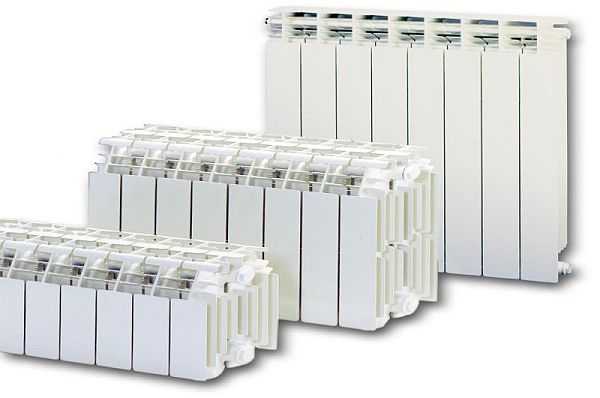

The lowest radiator at Global Gl-200/80 / D has a height of 200 mm
Steel
Steel panel radiators are rarely produced with a center distance of 500 mm. But still, there are some. For example, the Kermi campaign made the following connection dimensions specially for the replacement: they are in the Plan-K and Profil-K line. There are also standard-sized radiators in the Russian one: the RSV-1 model.
Tubular radiators delight with an abundance of models and sizes. It is quite easy to find the required dimensions here. The Russian] KZTO [/ anchor] has it, the Europeans have it. In this category, they operate more with a total height - mounting, since many prefer a bottom connection.
Tall and narrow
High radiators, even in the usual design, look unusual. And if you paint it in a non-standard color, give it an unusual shape, combine it with a mirror or a shelf, it turns out, in general, more like a designer thing than a banal heating device.
Let us immediately disappoint cast iron lovers: the highest cast-iron radiator is in the area of a meter. We have not met above. The same can be said about bimetallic ones - they cannot be higher than a meter. And in general, all that is in the bimetal is 760-860 mm or so.
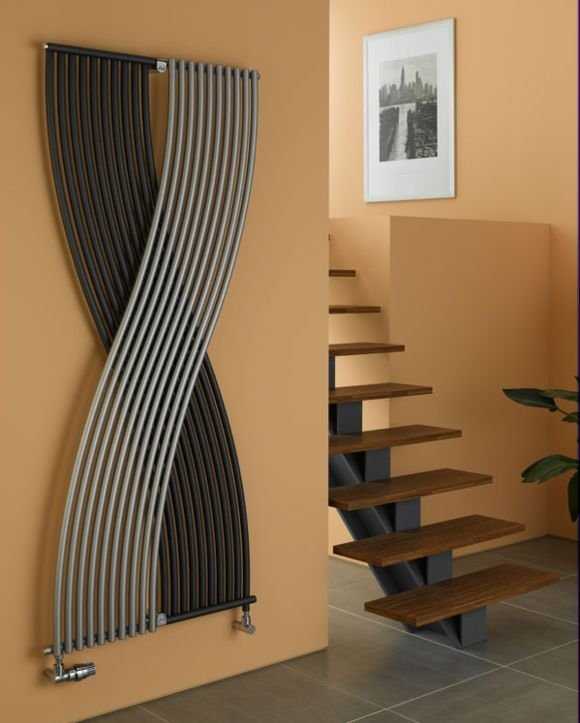

One of the most attractive models is the Arbonia Entreetherm vertical tubular radiator
Steel panel batteries as standard come in heights up to 900 mm. But there are also special models that can reach two meters and more. For example, Kermi has two models Verteo Plan and Verteo Profil - the maximum they can be up to 2.2 m. Purmo also has giants: Kos V, Faros V, Tinos V, Narbonne V and VT, Paros V. They differ in the type of front panel (smooth or profiled) and depth. But they all have only a bottom connection.
Steel tubular radiators are available up to 3000 mm high. Moreover, if necessary, some manufacturers can do higher. There are high models from any manufacturer: everyone who is present on the market offers such non-standard options "on order". Here we list only the most interesting in terms of design: Entreetherm, Planterm from Arbonia, Dekor series from Kermi, Harmony from Russian KZTO, Charleston from Zender.
In other types, there are no tall radiators. The choice, and so, I must say, is considerable. I would not be at a loss.
Choosing a bimetallic radiator
After making a decision to replace a cast-iron radiator with a bimetallic sample or purchase a new similar device, it is necessary to focus on a specific model. For the final choice, you must:
- Stop at some kind of radiator;
- Explore the market for materials for the manufacture of radiators;
- Determine the efficiency for the analysis of parameters such as the throughput and heat transfer of bimetallic heating radiators, the calculation of which must be carried out separately;
- To measure the weight of the device, which will make it easy enough to understand what material it is made of. For example, bimetallic radiators are outwardly similar to aluminum ones, but have a 55% weight difference.
Bimetallic radiators can be produced:
Technical characteristics of cast iron radiators
- With the use of solid steel, fixed to the radiator frame according to all technical requirements;
- Using steel sheets not over the entire surface of the devices, but at the locations of the heating tubes.
In the first case, bimetallic heating radiators, height 800 are more protected from corrosion. When using steel sheets, a more accurate and scrupulous assembly is necessary to avoid displacement of the plates, and, as a result, reduce efficiency.
There is a peculiar feature of bimetallic radiators - after the heating of the metal and its expansion, certain noises and sounds of hot water circulation occur.
It is also useful to know what is better to choose - aluminum or bimetallic radiators, about their advantages and disadvantages.
Low radiators
All heaters, the center distance of which is less than 400 mm, can be considered low. And here they offer many different models.
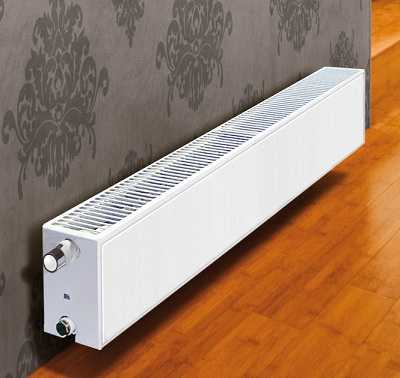

Steel panel radiators are very low
In the cast iron group, the minimum center distance for the BOLTON 220 model with an installation height of 330 m is slightly higher than the Hellas 270 from Viadrus: it has an installation height of 340 mm.All others are taller - with a center-to-center distance of 300-350 mm or so.
Among the aluminum radiators, the smallest have] Sira [/ anchor], their installation height is 245 mm, and the center-to-center height is 200 mm. These are the Alux and Rovall models with a depth of 80 mm and 100 mm. The models of another well-known] Global [/ anchor] (Global) - model Gl-200/80 / D and the Russian "Rifar" - "Base 200" and "Forza 200" have similar dimensions.
All manufacturers have slightly larger aluminum batteries (with a center-to-center 300 mm and more). There is a wide choice.
The same Rifar and Sira have bimetallic low radiators: the heights are 245 mm and 264 mm, respectively. But most of all models have 350 mm connecting dimensions. Any manufacturer has them. Such a distance, in fact, can also be attributed to the standard - everyone has it.
There is even more choice in the group of steel radiators. The smallest panel panels are produced by Purmo - Purmo Planora and Ramo Compact - their center distance is 150 mm, and their height is 200 mm.
For all other manufacturers, the height starts from 300 mm. Moreover, the length can be up to 3 meters (the step of its change is 100 mm).
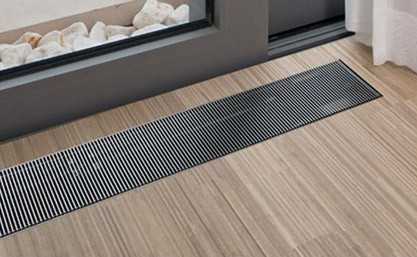

Floor radiators are the lowest possible
Tubular radiators are also very small: from 150 mm Delta Laserline sizes (manufactured by Purmo). In Arbonia, the height of all models of tubular radiators starts from 180 mm, in Zehnder from 190 mm (model Charleston), in the Russian KZTO from 300 mm.
There are low copper and copper-aluminum radiators. They are mainly produced in small dimensions - they have great power, and the price is also rather big. The lowest models are as follows: Ukrainian "Thermia" - height from 200 m, Polish Regulus-sistem - all models with height from 215 mm; Russian "IsoTerm" - from 215 mm; Chinese Mars (sectional type) with a height of 385 mm.
And the lowest can be considered the convectors built into the floor. They do not protrude above the floor level at all, but are placed for heating solid glazing, or built into the window sills of panoramic windows. There are they of different power and purpose, they can be used as additional or main heating.
Flat radiators
In some cases, it is not the height, but the depth of the radiators that plays a role: flat batteries are needed. Here the choice is not very large.
Shallow depth aluminum radiators are produced by Zlatoust Thermal. Their RAP 500 and RAP 300 models have a depth of 52 mm, while the thermal power is decent - 161 W and 105 W.
Panel radiators can be considered flat: depending on the number of heating panels, they have a depth of 60 mm. Also the thickness is small.
A small depth happens in tubular steel radiators: two-pipe radiators are made with a thickness of 50 mm, three-pipe ones from 100 mm to 110 mm, all the others are already more solid - from 135 mm and more.
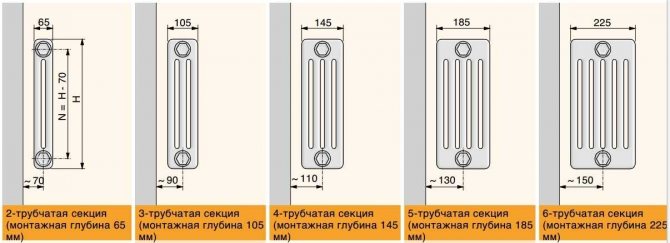

Steel pipe radiator can have from two to six columns of pipes
Neither bimetal, nor, especially cast iron, is flat. But there is a very good and perfect flat type of heating - a warm plinth. With such a system, heating devices are located along the floor along the perimeter. At the same time, their dimensions are about 30 mm in depth and 100-120 mm in height.
Technical characteristics of bimetallic heaters
Modern heating devices are distinguished by their lightness, high quality and excellent conductivity of thermal energy; their installation is quite simple. The surface of the heaters is metal, it easily absorbs heat and gives it to the space of the room, quickly heating it. The surface temperature is always higher than the air temperature.
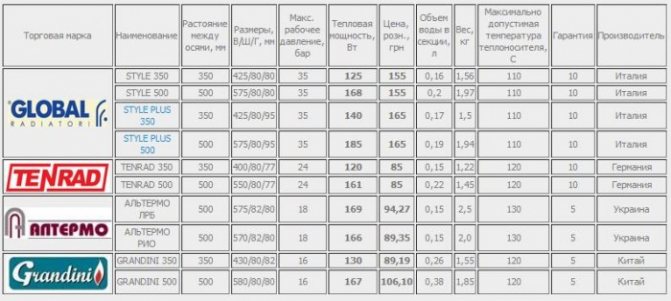

Technical characteristics of bimetallic batteries of some manufacturers
Modern bimetallic heating radiators, the characteristics of which you will like, are aesthetic in terms of external design, easily fit into the interior. The sizes of bimetallic heating radiators are different, which makes it easy to choose them.Their safety is increased thanks to the barriers. The following characteristics must correspond to the high quality of radiators:
- High strength;
- Maintaining pressure over 25-30 atmospheres;
- Withstanding the pressure of driving hot water.
Bimetallic radiators meet these characteristics, while they have a pleasant appearance.
Other important indicators of bimetallic radiators include the following:
- Long term of operation;
- The ubiquitous heat transfer of bimetallic heating radiators to all parts of the room;
- Resistance to mechanical damage;
- Aesthetic appearance.
Bimetallic radiators are suitable and effective even in rooms with high humidity. They are not subject to corrosion damage. This is facilitated by the manufacture of the upper surface of the radiator from sheet steel. Due to the small size of the channels inside the radiators, hot water is more quickly supplied from the central heating system or boilers. Bimetallic heating radiators, height 300mm are more expensive, but the reliability and durability of operation are worth it. In addition, in the very first years, thanks to their economy, these costs are fully paid off.
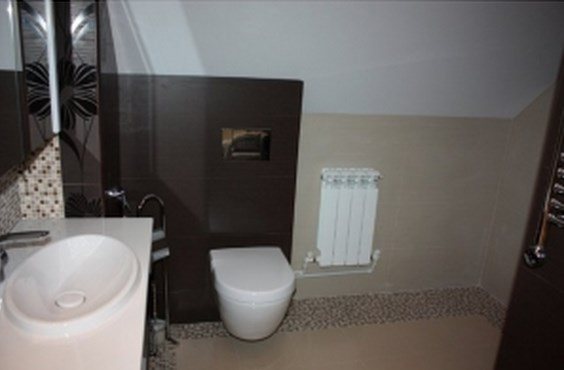

Heating radiator in the bathroom
